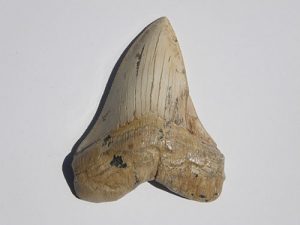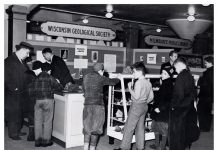
Jim Brace-Thompson
Shark teeth are fun fossils because (like dinosaurs) sharks are fearsomely fascinating and (unlike dinosaurs) their fossils are common. A shark may have as many as 50 teeth in a row, and behind them are six to 20 more rows, bent back and ready to spring forward as front teeth are shed. A single shark may shed 35,000 teeth over its lifespan! These are made of durable enamel, which aids in fossilization.
These two factors account for the abundance of fossil shark teeth. Fossil shark teeth come in varied colors, sizes, and shapes. Teeth of living sharks are white but, as they fossilize, they take on colors of minerals in sediments in which they’re buried and become tinted yellow-orange, tan, brown, gray or black. They vary in size depending on species. The largest, belonging to Carcharocles megalodon, can reach 7 inches. Most are under an inch.
Variation of Teeth Speaks to Species

Teeth also vary in shape. Different species have different types of teeth for different functions: flattened enamel for crushing crustaceans; pointed teeth for spearing fish; serrated teeth for tearing chunks from marine mammals. Just as our incisors and molars are different, the same shark may have very different teeth. A shark may have smooth bottom teeth for stabbing and grabbing, and serrated upper teeth for slicing and dicing. This variation in shape and function makes it difficult to identify the species of fossil shark teeth.
Sharks have an ancient lineage. The first forms date back 400 million years! Because they’ve been around so long, they’re found in sedimentary rocks around the world. Moroccan phosphate mines are especially known for them. They’re common in many places throughout the United States. I’ve collected them in Illinois limestone quarries, New Jersey stream beds, Nebraska and California hillsides, the Chesapeake Bay cliffs in Maryland, and the Gulf beaches of Florida.
Author: Jim Brace-Thompson
 Founder and overseer of the AFMS Badge Program for kids.
Founder and overseer of the AFMS Badge Program for kids.
He’s also an inductee of the National Rockhound & Lapidary Hall of Fame within the Education Category.















